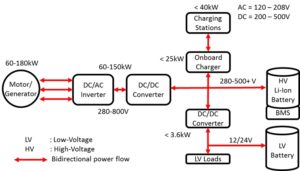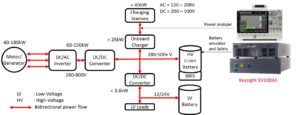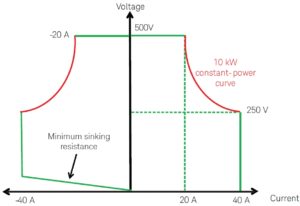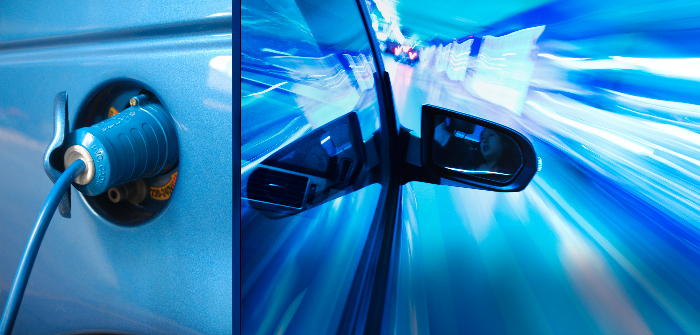How Keysight’s compact, two-quadrant, regenerative power converter test solution with integrated safety features accelerates test time, and protects both users and devices under test
Vehicle electrification continues to increase as electric components provide greater reliability – enabling OEMs to meet green energy goals. The most noticeable change is the addition of high-voltage, high-power batteries to a platform that was traditionally 12V. These high-voltage, high-power batteries in HEV/EV of 300V and higher stack up testing costs and risks. A new test paradigm is needed to address the high-voltage, high-power environment in these vehicles.
The need for power conversion
The battery is the heart of an electric vehicle. Its voltage and power must be high, to provide the long-lasting energy needed to power the electric vehicle for longer range. Power converters are necessary to take the high-voltage DC from the battery and convert that into respective voltages and currents required to power the different systems within the HEV/EV, as shown in Figure 1.
Not all systems in the vehicle work on the same voltage as the battery. Headlights, infotainment and driver assistance operate at 12V DC. Power-demanding loads like heating, electric/hydraulic power steering (EPS/EHPS) and roll stabilization operate at 48V DC.
The onboard charger (OBC) which charges the battery in HEV/EV from the power grid is an AC/DC system. It converts the AC power from the grid to the DC power as required by the battery. There are also AC components and loads in the vehicle, such as the motor and the generator. The DC power from the battery is converted into AC to power the motor. Similarly, the AC power generated from the regenerative braking is converted into DC power to be stored in the battery.
Why high power conversion efficiency is important
Power conversion efficiency assesses how well the conversion of one form of power to another is implemented. The efficiency is measured simply by dividing the output power in watts by the input power in watts and is expressed as a percentage. The efficiency of power converters is typically more than 90%.
The higher the efficiency of a power conversion process, the less power is wasted. Maximizing power conversion efficiency is important as wasted power has many costs. High power conversion efficiency translates into paying less for consumed energy, quicker and less frequent recharging, higher vehicle range, and more environmental friendly vehicles.
Rapid advances in the HEV/EV markets are driving the need for higher efficiency power conversion techniques as vehicle electrification gain increased popularity. These developments contribute to the need to properly measure and manage your design’s power consumption. Accurate measurement of power conversion is key to reducing energy consumption and improving power conversion efficiency.
Power converter test challenges
Advanced wide bandgap semiconductors such as silicon carbide (SiC) and gallium nitride (GaN), enable the high-voltage and high-power operations in HEV/EV. As with any new technologies, there are new challenges to address. Engineers need to consider the implications of high-voltage, high-power design and test to minimize cost, meet safety regulations, avoid circuit breakdown, electromagnetic interference (EMI), thermal issues, and so on.
Test equipment suitable for handling high voltage and high power can be many times more expensive than low-power equipment. Operating expenses will increase, as the amount of electricity consumed by a 10kW power source is 10 times that of 1kW when sourcing full power. All this power creates an enormous amount of heat which needs to be dissipated. The cooling system helps to mitigate heat but with the cost of increased footprint. To comply with high-voltage safety regulations, a safety disconnect system needs to be considered. The support and maintenance plans get more complex if these systems are to be deployed worldwide. All this results in high costs.
Power converters in HEV/EV have bidirectional energy flow. Testing bidirectional and regenerative energy systems and devices requires a two-quadrant solution to source and sink, just like the battery. In a design and test environment, a battery is not an effective test instrument as you cannot set the voltage or other characteristics to the specific test you need to make. Many existing solutions resort to using separate instruments for sourcing and sinking, i.e. DC supplies and electronic loads, as there is a lack of instruments available to adequately address these test needs.
This common approach is not only difficult to implement but one must also coordinate the control and data acquisition of the instruments. There are also discontinuities at the transition between source and sink, causing a potential ‘deadband’ when connecting DC source and electronic load to test bidirectional devices. Some may even require a power supply blocking diode to isolate and prevent reverse current from flowing back to the DC source when the device is actively sourcing power, thereby decreasing control and accuracy.
The smart way going forward
The new way to test power converters should address the test challenges and shortcomings of the common test approach. One example is the Keysight EV1003A Power Converter Test Solution, which is ideal for testing HEV/EV power converters such as the OBC, as depicted in Figure 2. The EV1003A comprises of three instruments: the RP7900 series regenerative power system which takes the place of the battery in the test setup; the PA2200 series IntegraVision power analyzer which performs power measurements; and the SD1000 safety disconnect solution which handles faults and ensures output is secured.
A high-voltage, high-power battery emulator with a small footprint
The EV1003A takes up only 3U rack space for 10kW of sourcing and loading compared to the typical 6kW at 4U and 12kW at 6U. Figure 3 shows the autoranging output characteristic of the RP7900. This capability replaces the need for multiple power supplies because the EV1003A expands the power curve, giving the user more voltage and current combinations in one power supply. When more power is needed, it is possible to create a system of up to 150kW through easy parallel connection.
The core of the EV1003A solution is the RP7900. It provides the battery emulation capabilities for vehicle electrification tests, such as two-quadrant (source/sink) operation and programmable output resistance. For example, the RP7900 can be used as a source power to test the vehicle’s systems and sink power to test the vehicle’s onboard charging system and regenerative braking. Compared to the common approach, DC accuracy and dynamic performance are now optimized rather than compromised. Measurement performance is greatly improved by having a single measurement system for all currents.
Cost saving and ‘green’ with clean regeneration
The regenerative capabilities of the RP7900 also enable the energy consumed to be put back into the grid. Cost and usage of electricity is reduced with efficiency of more than 85% when sourcing and sinking/regenerating. Less heat is dissipated; hence less cooling is required when sinking. Interference with other electronics is minimized with clean power being returned to the grid. The performance of regeneration is typically less than 3% total harmonic distortion at full load.
The IntegraVision power analyzer makes HEV/EV testing for AC and DC power measurements simple. It measures power on any of the vehicle’s power converters, such as the AC-to-DC power conversion efficiency of the on-board charger.
Safeguard test personnel and devices under test
The safety disconnect system is designed to work exclusively with the RP7900 Series. In response to a fault, the safety disconnect will remove the output voltage in less than 15ms. Faults can be generated by the RP7900 or the user by means of the emergency switch. It also complies with EMC and safety regulations.
Keysight has designed a solution specifically to address the safety, regulatory, and environmental issues facing the HEV/EV market. This solution is the only commercial-off-the-shelf regenerative power system with highly integrated safety features that protect test personnel and devices under test. The regenerative capabilities enable the energy consumed to be put back into the grid cleanly, saving costs from energy consumption and cooling, while not interfering with the grid. Keysight’s solution and worldwide support give users the confidence to deploy high-voltage, high-power solutions to meet the fast paced, high-growth demands of the HEV/EV market.
Figure 1: In a typical HEV/EV, power converters are needed to convert one form of power into another from either internal or external sources

Figure 2: An example setup of the EV1003A used in testing the OBC in a HEV/EV

Figure 3: Autoranging output characteristic of the 10kW RP7900



